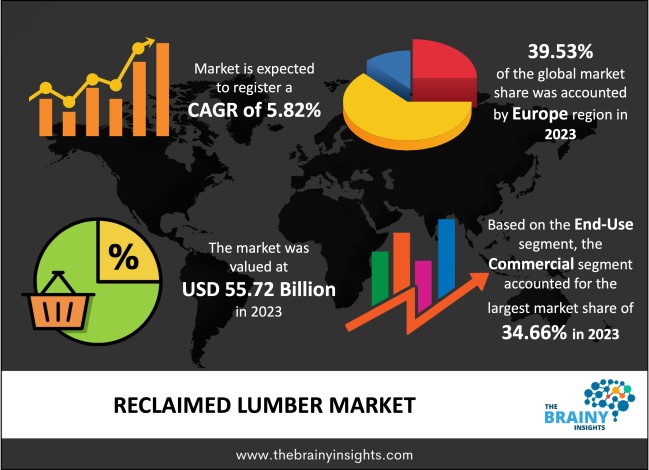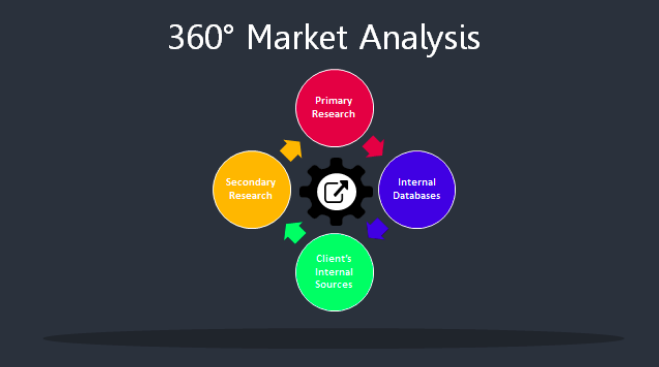- +1-315-215-1633
- sales@thebrainyinsights.com

The global reclaimed lumber market was valued at USD 55.72 Billion in 2023, which is anticipated to grow at a CAGR of 5.82% from 2024 to 2033. Increasing recycling rates, heightened environmental consciousness, and more robust waste management-related policies are some of the drivers of market expansion. The building industry has noticed a growing trend towards sustainable building with cross-laminated timber (CLT). Demand for the product is anticipated to increase because of the growing usage of reclaimed timber in CLT goods and the growing preference of architects, developers, and engineers for tall wooden buildings in order to lessen their environmental carbon footprint.
Reclaimed timber, sometimes referred to as salvaged or reclaimed wood, is a popular sustainable building resource because of its distinct character and advantages for the environment. It comes from discarded wood items like shipping pallets and wine barrels, or from historic buildings like barns, factories, and warehouses. To rescue usable wood, these structures must be meticulously dismantled in order to produce reclaimed lumber. After that, the recovered wood is cleaned, processed, and ready to be used again in a variety of design and building contexts. Reclaimed wood has several benefits, such as less need for recently harvested trees, less trash going to landfills, and a unique worn look that gives projects a charming, genuine look. Reclaimed lumber is frequently found in pallet wood, which is prized for its rustic texture, and barn wood, which has weathered patinas and nail holes. The growing need for eco-friendly building materials and methods has an impact on the global market for reclaimed lumber. In addition, strict environmental laws and initiatives to lessen carbon emissions promote the use of recycled wood, which is favourably influencing the market's expansion. In addition, the expansion of the furniture and building sectors is driving up demand for unusual and reasonably priced materials like reclaimed lumber, which is driving up market growth. The market is also growing as a result of consumers' growing awareness of the aesthetic and historical significance of reclaimed wood as well as their growing emphasis on resource conservation and waste reduction. The market is expanding due to a number of other causes, including the growing popularity of do-it-yourself projects and artisanal crafts as well as government and organisation activities to encourage sustainable practices and green building standards. Reclaimed lumber is wood that has been treated and taken out of its original use for a different purpose. Although some businesses employ wood from less conventional constructions like boxcars, coal tunnels and wine barrels, the majority of reclaimed timber originates from timber and decking salvaged from ancient barns, factories and warehouses. Antique or reclaimed wood is mostly utilised for flooring, furniture, cabinetry, architectural elements, siding, and other house construction and decorative purposes. Reclaimed wood is premium repurposed wood that has been removed from a variety of locations, including warehouses, ancient barns, animal farms, decommissioned ships, industries, and wine moulds. The majority of demolition companies salvage timber from abandoned buildings since the market for their products is expanding. Wood taken from historic buildings, such as barns or warehouses, that are scheduled for demolition is referred to as reclaimed lumber. This timber is treated, recovered, and used for new building or creative activities. The unique patterns, colours, and textures that have formed over years of weathering are what give it its beauty. This environmentally friendly method diminishes the impact of logging on the environment, conserves resources, and decreases the demand for new wood. Reclaimed lumber is becoming more and more common in homes and businesses, which is indicative of a trend towards environmentally responsible and distinctive building materials.

Get an overview of this study by requesting a free sample
Growing need for environmentally friendly building materials- The increased emphasis on sustainable building practices is driving a considerable surge in demand for reclaimed lumber in the global market. Architects, builders, and homeowners are actively looking for alternatives to standard timber as environmental consciousness grows. A good option is to use reclaimed wood, which comes from abandoned buildings, barns, and other structures. The major driving force behind this trend is the aim to lessen the environmental effect of building projects. Reclaimed wood helps keep wood waste out of landfills and reduces the demand for new logging. With the growing popularity of green building certifications like LEED (leadership in energy and environmental design), reclaimed timber is becoming a more popular option for construction due to its eco-friendly qualities. Reclaimed lumber is included in a way that adheres to sustainable design principles, thereby lowering carbon emissions and promoting a more circular use of resources. The market for reclaimed lumber is heavily impacted by strict environmental laws and the larger movement to reduce carbon emissions. Stricter laws are being passed by governments all over the world to reduce deforestation and encourage sustainable forestry practices. The construction and furniture manufacturing businesses are compelled by the current regulatory landscape to investigate environmentally friendly substitutes such as reclaimed lumber. Furthermore, the need for lower-impact materials is driving sectors to look for carbon offsets related to the logging, shipping, and processing of new timber. Reclaimed wood solves these issues by repurposing current resources without accelerating the loss of forest cover. The market for reclaimed lumber is being further supported by corporate social responsibility (CSR) activities, which are pushing businesses to choose sustainable sourcing in addition to regulatory drivers. Businesses support ethical and environmental ideals by selecting salvaged wood over new lumber, helping to create a more sustainable future.
Expansion of the furniture and building sectors in emerging economies- The global building and furniture sectors' growth trajectory, especially in emerging economies, is closely linked to that of the reclaimed lumber market. There is a soaring need for building supplies and furnishings as these nations undergo urbanisation, infrastructure development, and economic growth. Because of its particular character and historical relevance, reclaimed lumber is popular with both consumers and architects seeking for genuine, sturdy furniture. Reclaimed lumber is also more affordable than new lumber, which is in line with these markets' budget-conscious inclinations.
The regions analyzed for the market include North America, Europe, South America, Asia Pacific, the Middle East, and Africa. Europe emerged as the most significant global reclaimed lumber market, with a 39.53% market revenue share in 2023. It is because the building industry has experienced tremendous expansion and a rise in private investment. Due to the constantly expanding residential sector in the region and increased product demand from established economies like Germany and the UK, the regional market is expected to rise at a steady compound annual growth rate.
Europe Region Reclaimed Lumber Market Share in 2023 - 39.53%
www.thebrainyinsights.com
Check the geographical analysis of this market by requesting a free sample
The application segment is divided into paneling, furniture, flooring, beams & boards, and others. The furniture segment dominated the market, with a market share of around 23.58% in 2023. The segment's rise has been attributed to the high demand for custom-manufactured furniture, such as shelving and chairs, and antique furniture.
The end-use segment is divided into commercial, residential, and industrial. The commercial segment dominated the market, with a market share of around 34.66% in 2023. In the commercial sector, the product finds application in wall coverings, floors, tabletops, seating, and light fixtures, among other areas. The product's distinctive appearance and rustic style make it popular. The business sector frequently experiences wear and tear in high-traffic areas, which is sometimes concealed by the architectural aesthetic. Additionally, using products for interior purposes gives the design individuality, which is frequently favoured by the operators.
| Attribute | Description |
|---|---|
| Market Size | Revenue (USD Billion) |
| Market size value in 2023 | USD 55.72 Billion |
| Market size value in 2033 | USD 98.10 Billion |
| CAGR (2024 to 2033) | 5.82% |
| Historical data | 2020-2022 |
| Base Year | 2023 |
| Forecast | 2024-2033 |
| Region | The regions analyzed for the market are Asia Pacific, Europe, South America, North America, and Middle East & Africa. Furthermore, the regions are further analyzed at the country level. |
| Segments | Application, End-use |
As per The Brainy Insights, the size of the reclaimed lumber market was valued at USD 55.72 Billion in 2023 & USD 98.10 Billion by 2033.
Global reclaimed lumber market is growing at a CAGR of 5.82% during the forecast period 2024-2033.
Europe region emerged as the largest market for the reclaimed lumber.
Growing need for environmentally friendly building materials is a significant driving factor for the growth of the reclaimed lumber market.
Expansion of the furniture and building sectors in emerging economies is a significant opportunity for the growth of the reclaimed lumber market.
Key players are Carpentier Hardwood Solutions NV, TerraMai, Elemental Republic, Trestlewood, Beam and Board, LLC, Vintage Timberworks, Inc., Altruwood, Imondi Flooring, Olde Wood Ltd., True American Grain Reclaimed Wood, Jarmak Corporation, among others.
This study forecasts revenue at global, regional, and country levels from 2020 to 2033. The Brainy Insights has segmented the global reclaimed lumber market based on below mentioned segments:
Global Reclaimed Lumber by Application:
Global Reclaimed Lumber by End-use:
Global Reclaimed Lumber by Region:
Research has its special purpose to undertake marketing efficiently. In this competitive scenario, businesses need information across all industry verticals; the information about customer wants, market demand, competition, industry trends, distribution channels etc. This information needs to be updated regularly because businesses operate in a dynamic environment. Our organization, The Brainy Insights incorporates scientific and systematic research procedures in order to get proper market insights and industry analysis for overall business success. The analysis consists of studying the market from a miniscule level wherein we implement statistical tools which helps us in examining the data with accuracy and precision.
Our research reports feature both; quantitative and qualitative aspects for any market. Qualitative information for any market research process are fundamental because they reveal the customer needs and wants, usage and consumption for any product/service related to a specific industry. This in turn aids the marketers/investors in knowing certain perceptions of the customers. Qualitative research can enlighten about the different product concepts and designs along with unique service offering that in turn, helps define marketing problems and generate opportunities. On the other hand, quantitative research engages with the data collection process through interviews, e-mail interactions, surveys and pilot studies. Quantitative aspects for the market research are useful to validate the hypotheses generated during qualitative research method, explore empirical patterns in the data with the help of statistical tools, and finally make the market estimations.
The Brainy Insights offers comprehensive research and analysis, based on a wide assortment of factual insights gained through interviews with CXOs and global experts and secondary data from reliable sources. Our analysts and industry specialist assume vital roles in building up statistical tools and analysis models, which are used to analyse the data and arrive at accurate insights with exceedingly informative research discoveries. The data provided by our organization have proven precious to a diverse range of companies, facilitating them to address issues such as determining which products/services are the most appealing, whether or not customers use the product in the manner anticipated, the purchasing intentions of the market and many others.
Our research methodology encompasses an idyllic combination of primary and secondary initiatives. Key phases involved in this process are listed below:

The phase involves the gathering and collecting of market data and its related information with the help of different sources & research procedures.

The data procurement stage involves in data gathering and collecting through various data sources.
This stage involves in extensive research. These data sources includes:
Purchased Database: Purchased databases play a crucial role in estimating the market sizes irrespective of the domain. Our purchased database includes:
Primary Research: The Brainy Insights interacts with leading companies and experts of the concerned domain to develop the analyst team’s market understanding and expertise. It improves and substantiates every single data presented in the market reports. Primary research mainly involves in telephonic interviews, E-mail interactions and face-to-face interviews with the raw material providers, manufacturers/producers, distributors, & independent consultants. The interviews that we conduct provides valuable data on market size and industry growth trends prevailing in the market. Our organization also conducts surveys with the various industry experts in order to gain overall insights of the industry/market. For instance, in healthcare industry we conduct surveys with the pharmacists, doctors, surgeons and nurses in order to gain insights and key information of a medical product/device/equipment which the customers are going to usage. Surveys are conducted in the form of questionnaire designed by our own analyst team. Surveys plays an important role in primary research because surveys helps us to identify the key target audiences of the market. Additionally, surveys helps to identify the key target audience engaged with the market. Our survey team conducts the survey by targeting the key audience, thus gaining insights from them. Based on the perspectives of the customers, this information is utilized to formulate market strategies. Moreover, market surveys helps us to understand the current competitive situation of the industry. To be precise, our survey process typically involve with the 360 analysis of the market. This analytical process begins by identifying the prospective customers for a product or service related to the market/industry to obtain data on how a product/service could fit into customers’ lives.

Secondary Research: The secondary data sources includes information published by the on-profit organizations such as World bank, WHO, company fillings, investor presentations, annual reports, national government documents, statistical databases, blogs, articles, white papers and others. From the annual report, we analyse a company’s revenue to understand the key segment and market share of that organization in a particular region. We analyse the company websites and adopt the product mapping technique which is important for deriving the segment revenue. In the product mapping method, we select and categorize the products offered by the companies catering to domain specific market, deduce the product revenue for each of the companies so as to get overall estimation of the market size. We also source data and analyses trends based on information received from supply side and demand side intermediaries in the value chain. The supply side denotes the data gathered from supplier, distributor, wholesaler and the demand side illustrates the data gathered from the end customers for respective market domain.

The supply side for a domain specific market is analysed by:
The demand side for the market is estimated through:
In-house Library: Apart from these third-party sources, we have our in-house library of qualitative and quantitative information. Our in-house database includes market data for various industry and domains. These data are updated on regular basis as per the changing market scenario. Our library includes, historic databases, internal audit reports and archives.
Sometimes there are instances where there is no metadata or raw data available for any domain specific market. For those cases, we use our expertise to forecast and estimate the market size in order to generate comprehensive data sets. Our analyst team adopt a robust research technique in order to produce the estimates:
Data Synthesis: This stage involves the analysis & mapping of all the information obtained from the previous step. It also involves in scrutinizing the data for any discrepancy observed while data gathering related to the market. The data is collected with consideration to the heterogeneity of sources. Robust scientific techniques are in place for synthesizing disparate data sets and provide the essential contextual information that can orient market strategies. The Brainy Insights has extensive experience in data synthesis where the data passes through various stages:


Market Deduction & Formulation: The final stage comprises of assigning data points at appropriate market spaces so as to deduce feasible conclusions. Analyst perspective & subject matter expert based holistic form of market sizing coupled with industry analysis also plays a crucial role in this stage.
This stage involves in finalization of the market size and numbers that we have collected from data integration step. With data interpolation, it is made sure that there is no gap in the market data. Successful trend analysis is done by our analysts using extrapolation techniques, which provide the best possible forecasts for the market.
Data Validation & Market Feedback: Validation is the most important step in the process. Validation & re-validation via an intricately designed process helps us finalize data-points to be used for final calculations.

The Brainy Insights interacts with leading companies and experts of the concerned domain to develop the analyst team’s market understanding and expertise. It improves and substantiates every single data presented in the market reports. The data validation interview and discussion panels are typically composed of the most experienced industry members. The participants include, however, are not limited to:
Moreover, we always validate our data and findings through primary respondents from all the major regions we are working on.
Free Customization
Fortune 500 Clients
Free Yearly Update On Purchase Of Multi/Corporate License
Companies Served Till Date